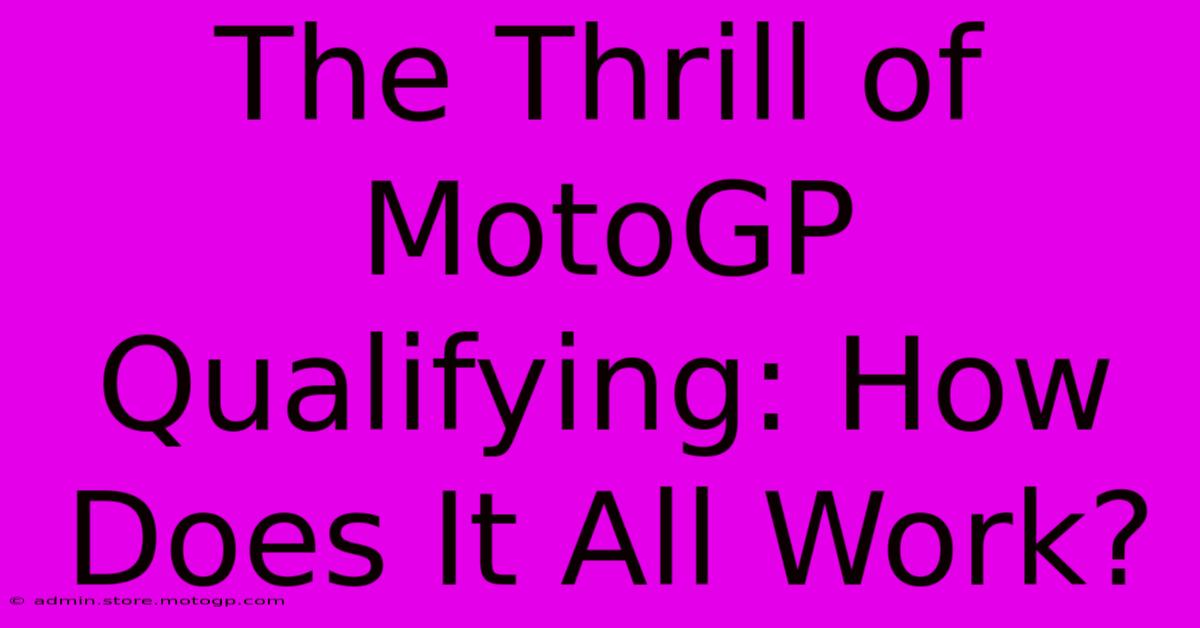The Thrill Of MotoGP Qualifying: How Does It All Work?

Table of Contents
The Thrill of MotoGP Qualifying: How Does It All Work?
The roar of the engines, the smell of burning rubber, the sheer spectacle of 20+ MotoGP bikes battling for pole position – qualifying is arguably the most intense part of a Grand Prix weekend. But how does it all work? This guide delves into the intricacies of MotoGP qualifying, explaining the format, the strategies, and the drama that unfolds every race weekend.
Understanding the Qualifying Format
MotoGP qualifying isn't a simple sprint race. It's a carefully structured process designed to determine the starting grid for Sunday's race. The format has evolved over the years, but the core principle remains the same: separate the fastest riders from the rest.
Q1 and Q2: A Two-Tiered System
The qualifying sessions are divided into two parts: Q1 and Q2. The riders are initially ranked based on their combined times from Friday's free practice sessions (FP1 and FP2). The slowest ten riders from this combined time sheet start in Q1. The remaining 10 fastest riders automatically progress to Q2.
Q1 (15 minutes): This session is a frantic battle for survival. The top two riders from Q1 automatically progress to Q2, joining the ten who already qualified. Those who don't make it, sadly, start at the back of the grid for the race. This adds an extra layer of pressure and drama to the session.
Q2 (15 minutes): This is the ultimate showdown. The twelve riders in Q2 fight for pole position and the coveted front row starting slots. The rider with the fastest lap time earns pole position, with the next two riders securing places on the front row. The remaining positions are determined by lap times, creating the starting grid for Sunday's race.
Strategies and Tactics: More Than Just Speed
While raw speed is paramount, MotoGP qualifying is a tactical game. Teams and riders utilize various strategies to maximize their chances of securing a good grid position. These include:
Tire Management: Choosing the right tires for qualifying is crucial. Using a softer compound might offer a faster lap time, but it could compromise race performance if the tire degrades quickly. Teams carefully consider the track conditions and forecast to determine the optimal tire choice.
Slipstream Tactics: Riders often utilize the slipstream (drafting) to gain a significant speed advantage. This involves following closely behind another rider to reduce air resistance and improve lap times. The timing and execution of slipstreaming maneuvers are crucial and require a level of skill and teamwork.
Track Conditions: The ever-changing track conditions throughout the weekend heavily influence the qualifying strategy. Factors such as temperature, humidity, and even track debris can affect tire performance and lap times. Experienced riders and teams expertly adapt their approaches based on the prevailing conditions.
Data Analysis: Extensive data analysis plays a pivotal role. Teams meticulously analyze the rider's performance, the bike setup and telemetry to fine-tune their strategy, aiming for optimal performance and maximizing qualifying potential.
The Importance of Pole Position
Securing pole position is more than just bragging rights; it provides a significant advantage in the race. Starting from the front allows riders to control the pace, avoid the initial chaos, and set the race strategy.
Advantages of Pole Position:
- Clean Start: The lead rider avoids the first-corner chaos.
- Race Control: Set the pace for the race.
- Less Tire Degradation: Avoid early tire degradation in the battles for position.
The Drama and Excitement
The intensity of MotoGP qualifying is undeniable. The fight for every tenth of a second, the desperate maneuvers for slipstreams, and the high-stakes pressure create a captivating spectacle that keeps fans on the edge of their seats. Every session offers a unique blend of tension, excitement and nail-biting moments until the checkered flag drops.
In conclusion, MotoGP qualifying is a multifaceted process that combines speed, strategy, and technology. Understanding the format, strategies, and importance of pole position reveals the complexity and excitement of this crucial part of the Grand Prix weekend. So, next time you watch MotoGP qualifying, you'll appreciate the intricate dance of skill, precision, and daring that decides the starting grid and sets the stage for a thrilling race.

Thank you for visiting our website wich cover about The Thrill Of MotoGP Qualifying: How Does It All Work?. We hope the information provided has been useful to you. Feel free to contact us if you have any questions or need further assistance. See you next time and dont miss to bookmark.
Featured Posts
-
Moto Gp Commentary A Global Phenomenon
Feb 18, 2025
-
Moto Gp Arcade Game Addictive Gameplay You Wont Want To Stop
Feb 18, 2025
-
Find Your Perfect Sanctuary In Cota Lot A
Feb 18, 2025
-
Pushing The Limits Us Grand Prix Sprint Time Innovations
Feb 18, 2025
-
Circuit Of The Americas The Epitome Of Racing Hospitality
Feb 18, 2025
